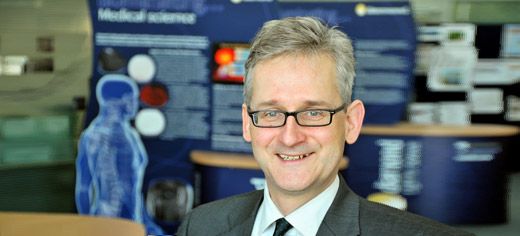
Professor Sven Schroeder has been appointed to a new chair set up to lead research into the atomic structure of materials.
As the Royal Academy of Engineering Bragg Centenary Professor of Engineering Applications of Synchrotron Science, Professor Schroeder will have a key role in driving engineering research at the Diamond Light Source, the UK’s synchrotron science facility near Oxford, and in coordinating national and international research in the field.
Synchrotron science involves accelerating electrons to produce intense light—about 10 billion times brighter than the sun—that allows researchers to study matter in far greater detail than can be achieved by traditional microscopes.
It supports vital research ranging from the development of advanced automobile engines and more efficient chemical processes to creating advanced medicines.
Professor Schroeder said: “I am excited to be joining the University of Leeds, which has such a proud tradition in structural analysis dating back to the pioneering days of the discipline. My role will be to work with the University’s exceptionally diverse and interdisciplinary research community to develop collaborations with industry and ensure we make the best possible use of the synchrotron at Diamond and drive forward applied engineering in the UK.”
The Bragg Centenary Chair represents a major national collaboration between the Royal Academy of Engineering, Diamond Light Source Ltd., the fuel and lubricant additive developer Infineum UK Ltd. and the University.
It commemorates Nobel Prize-winning research by Professor William Henry Bragg at the University of Leeds in 1913-1914. Bragg’s work, along with that of his son William Lawrence Bragg, pioneered the scientific technique of X-ray crystallography, which proved to be one of the most important scientific developments of the 20th Century and now supports a rich variety of research taking place at modern synchrotrons. 2014 is the UNESCO International Year of Crystallography, marking the centenary of the 1914 breakthrough.
Professor Schroeder, who arrived at Leeds at the start of October, is a world-leading researcher who uses the latest X-ray techniques to characterise molecular structure and optimise chemical process systems and improve materials and products. His work impacts upon areas as diverse as nanotechnology, energy, electronics, chemical processing, pharmaceuticals and formulated products like fuel additives.
In his new role, based in the University’s School of Chemical and Process Engineering, Professor Schroeder will help build on the University of Leeds’ excellent reputation in process and materials engineering, drawing on state-of-the-art facilities for diffraction, spectroscopy, electron microscopy and process analytics. He will be working closely with Infineum and Diamond to coordinate engineering research in applied synchrotron science at Diamond and the Research Complex at Harwell, creating exceptional opportunities for research students.
Professor Schroeder studied Chemistry with Experimental Physics at the Freie Universität Berlin, followed by a PhD in applied surface science at the University of Cambridge. He built his early academic career as Oppenheimer Research Fellow at Cambridge, at the Fritz Haber Institute of the Max-Planck-Society in Berlin, and at the Freie Universität, before joining UMIST (now part of The University of Manchester) as a lecturer and later professor in the Schools of Chemical Engineering and Chemistry.
Professor Peter Jimack, Dean of the Faculty of Engineering at the University of Leeds, said: “This is a very important appointment for the University of Leeds and for synchrotron science nationally. Professor Schroeder brings an excellent record in research across a very wide range of practical applications and will play a key role in building collaborations with industrial partners and driving exciting interdisciplinary research at Leeds.”
Professor Andrew Harrison, CEO of Diamond Light Source, said: “Engineering is a key area of research at Diamond. We are able to offer industry and academia access to world class experimental facilities and expertise that can be used to gain a better understanding of how engineering processes and materials behave at the atomic level and under real conditions. Professor Schroeder’s extensive knowledge and experience of what the synchrotron can deliver will undoubtedly help us to attract some extremely exciting research projects to Diamond in the future.”
Professor Peter Dowding, Principal Scientist Infineum UK, who is an honorary Professor at The University of Leeds, said: “Infineum is proud to be co-sponsoring this prestigious role, which is a great example of collaboration between academia and industry at the very state of the art. The UK industry has an enviable track record in this field with some of the world's leading scientists and facilities, and this collaboration is helping us understand the performance of our products in unprecedented levels of detail.”
Professor Ric Parker, Vice-President for Research at the Royal Academy of Engineering, said: “The Academy is delighted to be involved in establishing the prestigious Bragg Centenary Chair. Our research chairs are designed to support the best engineering research and to encourage the development of world-class research groups.
“I am sure the work of Professor Schroeder will enhance the prestige of the University of Leeds and bring real impact to the UK economy. Close collaboration between the Chair and the industrial sponsors should help to generate a steady flow of innovation with both academic and industrial relevance.”
Image credit: Image courtesy of Diamond Light Source.
Further information
Professor Schroeder is available for interview. Photographs of Professor Schroeder are available from the University of Leeds press office. Contact Chris Bunting, Senior Press Officer, University of Leeds; phone +44 113 343 2049 or email c.j.bunting@leeds.ac.uk.